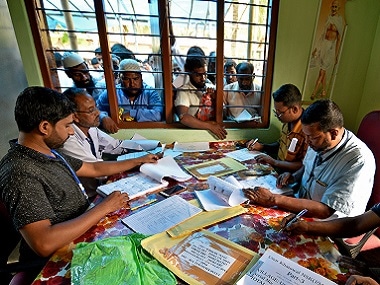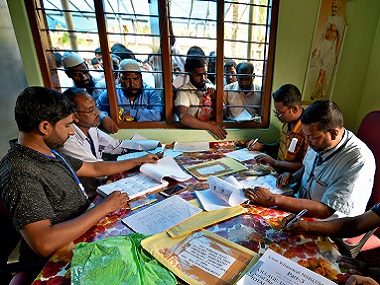In its latest order on the much-debated Assam NRC case, the Supreme Court of India imposed an unusual condition on the validity of the citizenship document in its present form. The order, signed by the Constitution Bench comprising Chief Justice Ranjan Gogoi and Justice Rohinton Fali Nariman, bears immense importance as the case Writ Petition (C) No 562 of 2012 questions the constitutional validity of the cut-off date accepted while updating the NRC. [caption id=“attachment_5636661” align=“alignleft” width=“380”]  An NRC centre in Assam. Reuters[/caption] The case was filed by Assam Sanmilita Mahasangha, an umbrella organisation of a number of ethnic groups, led by Matiur Rahman, an Assamese sub-nationalist Muslim. If the verdict of the case, which questions the validity of Clause 6(A) of the Citizenship Act, 1955 and demands that the cut-off date of the NRC update should be 1951 and not 1971, goes in favour of the petitioner, it might result in a manifold increase in the number of exclusions. The Supreme Court case in question bears significance at this moment as it is widely felt that the NRC update process has failed to contain Assam’s fast-changing demographic pattern caused by mass migration from Bangladesh. The final NRC left 1.9 million persons out of it, whereas the estimate put forward by many leaders regarding the number of illegal immigrants in India was far higher than that. Former Union Minister Inderjit Gupta had told the Parliament in 1997 that there were 10 million undocumented immigrants in India. Former Union Home Minister Kiren Rijiju in the year 2016 pegged the number of illegal immigrants at 20 million. What is the case all about The Assam NRC is being updated as per the conditions laid by the Assam Accord which mandates that any foreigner entering the north eastern state illegally after 24 March, 1971 would be detected and deported. The Assam NRC was envisaged to detect illegal immigrants in Assam. Significantly, the Indian Constitution has a cut-off date to determine the citizenship of a person who migrated from Pakistan. But after the Assam Accord was signed, a cut-off date to determine citizenship was included in the Citizenship Act for the state in the north east. A cut-off date specially for Assam has been widely debated as unconstitutional move by many quarters, as it contradicts the cut-off date mandated by Article 6 in the Indian Constitution. Article 6 relates to the rights of citizenship of certain persons who have migrated to India from Pakistan and says that a person who has migrated to the territory of India from the territory now included in Pakistan shall be deemed to be a citizen of India if the person migrated before 19 July, 1948 and has been ordinarily resident in the territory of India since the date of his migration. The Article also lays down guidelines for the persons who migrated to India after 19 July 1948. According to this provision, if the migrant has been registered as a citizen of India by an officer appointed by the Government of the Dominion of India on an application made by him to such officer before the commencement of the Constitution in the form and manner prescribed by that Government he would be considered an Indian citizen. Interestingly, the Article 6 also adds that no person shall be so registered unless he has been resident in the territory of India for at least six months immediately preceding the date of his application. The Article 6 decides upon 19 July, 1948 as the baseline for determining citizenship in India for those migrating from Pakistan. The case filed by Assam Sanmilita Mahasangha questions the constitutional validity of having a separate cut-off date for Assam. The petitioner also questions the changes in the citizenship law which contradicts Article 6 of the Indian constitution. The petition pleads to update NRC on the basis of 1951 Assam NRC which was prepared just three years after the cut-off date mentioned in the Constitution and also not to accept 1971 as the base year. The Supreme Court has already referred the case to Constitution Bench, which is hearing it. Since in the last order of the Supreme Court in the NRC case, it had been maintained that the NRC would be updated as per the orders issued in this case by the Constitution Bench, there lies a possibility of the cut-off date of the NRC being pushed back to the year 1951. What will happen if Asom Sanmilita Mahsangha gets a judgment in its favour The recently published NRC left out 1.9 million people, which is seen as a major disappointment by many among the Assamese sub-nationalist groups. The hope was that the number of excluded people would be much more. But there are also studies which show that migration of population from Bangladesh and Pakistan was much higher between 1951 and 1971 than during the period starting from the year 1971. Theories transpired by these studies suggest that the number of exclusions from the NRC would grow manifold if the cut-off date is pushed back to the year 1951. As per a study conducted by experts, namely Nandita Saikia (Centre for Study of Regional Development, Jawaharlal Nehru University), Apala Saha (Centre for Study of Regional Development, Jawaharlal Nehru University), Jayanta Kumar Bora (Public Health Foundation of India) and William Joe (Institute of Economic Growth), 6,08280 immigrants entered Assam from East Pakistan during the period between 1951 and 1971. On the other hand, only 24,415 entered during the period 1971 to 1991 and 3,323 persons entered Assam from 1991 to 2001. A judgment in the favour of Asom Sanmilita Mahsangha might result in a spike in the number of persons excluded from the citizenship register.
A Supreme Court case in question bears significance as it is widely felt that the NRC update process has failed to contain Assam’s fast-changing demographic pattern caused by mass migration from Bangladesh
Advertisement
End of Article


)

)
)
)
)
)
)
)
)



